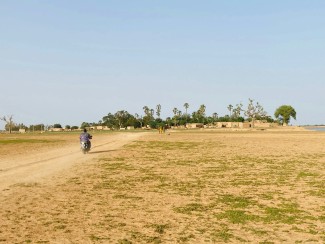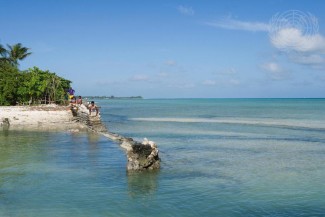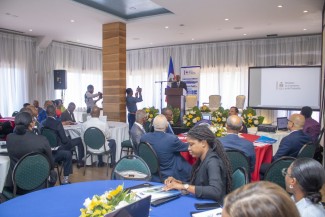This contribution draws on the article titled "Leveraging Aid for Trade to Mobilize Climate Finance" published by the author in the September 2022 edition of the Global Policy Journal.
Least Developed Countries (LDCs) emit the lowest level of greenhouse gases but are disproportionately affected by their effects. When it comes to addressing climate-induced vulnerabilities, finance is a major obstacle. In Africa, which houses 33 of the 46 LDCs, the UN estimates that about USD 2.4 trillion is needed to pay for measures to address climate-induced challenges. The Asia-Pacific region needs about USD 3.2 trillion.
There are at least three mechanisms from which LDCs can access funding: the Green Climate Fund, the LDC Fund, and the Adaptation Fund. But LDCs have struggled to access these resource due to complexity, uncertainty and fragmentation, as shown by an analysis.
A commitment by developed countries to raise USD 100 billion of public and private climate finance to LDCs has fallen short. Private climate finance to LDCs, though rising in recent years, still accounts for only 7% of all climate finance mobilized.
Other funding mechanisms must, therefore, be explored to fill the gap, for which Aid for Trade (AFT) could be a catalytic contributor. Launched in 2006, the Aid for Trade (AFT) Initiative has so far helped channel US$ 556 billion between 2006 and 2020 in official development assistance resources (ODA) resources for trade capacity building. Of this US$ 152 billion, accounting for 27.34% of the total disbursement, went to LDCs.
However, AFT is a limited source of financing for LDCs and could remain so due to shifting donor priorities, including due to Covid-19, climate change, and geopolitical tensions. Therefore, AFT should ideally be used as a catalytic instrument to mobilize other means of financing, including climate finance.
In addition, several climate-financing mechanisms, including the Green Climate Fund require high ratios of co-financing from participating governments. Marrying the two could unlock many economic infrastructure investments in AFT and be counted as co-financing contributions, as one study shows. Equally important is the possibility of using AFT to leverage climate finance, which is discussed below.
Leveraging climate finance
Although there are several options to leverage AFT to mobilize climate finance, this article focuses on six such possibilities by using various analytical, institution/policy and productive capacity building support.
First, AFT has been extensively used to conduct analytical work, including need assessments, such as diagnostic trade integration studies (DTIS) in the case of LDCs. Such studies identify priority actions to be undertaken by LDCs to take advantage of trade opportunities. However, these actions are not necessarily costed, nor the sources or modalities of mobilizing resources identified.
An idea worth pursuing is not only to calculate the resource requirements, but also to delineate the financing needs from the public and private sources. Following the national-level launch of the DTIS, a donor roundtable or investment summit can be organized to secure pledges from donors or investors for specific segments of priority actions based on their preferences.
Second, when it comes to creating synergy between AFT and climate finance, lack of coordination between trade and climate communities is a major hurdle. Through the institution/policy support window, it is possible to break down the silos between these two communities. In practice, this could be done by including the ministry responsible for climate matters in the policy-setting bodies on trade and development to ensure joint resource mobilization and project implementation.
In The Gambia, the Enhanced Integrated Framework (EIF) has been supporting government officials on how to access climate finance on trade-related topics; and developing closer collaboration between ministries responsible for trade and environment. To this end, a recent dialogue organized in Banjul marked the first step in reshaping The Gambia’s commitment in accessing trade-related climate finance. Topics such as modalities for accessing global financing for trade and climate change in the Gambian context were addressed during the event.
Third, although private investment, including foreign direct investment (FDI), remains an important source of external finance for LDCs to achieve their Nationally Determined Contribution targets, adverse financing conditions dissuade many would-be investors. Therefore, improving the investment climate in LDCs is of utmost importance for which AFT support can help, for example, preparing investor-friendly laws and policies, enhancing transparency of the rules and procedure, or by building capacity of investment promotion agencies to attract and retain FDI.
According to UNCTAD, LDCs have made significant reforms over the past decade. Between 2011 and 2021, two thirds of all LDCs enacted at least one policy measure on investment, compared to 54% of other developing countries. Policy initiatives to promote climate change adaptation and mitigation through FDI, in particular, focus primarily on the renewable energy and electricity sectors, which accounted for 60% of all measures adopted between early 2010 and mid-2022.
For example, Cambodia adopted a new Law on Investment offering various new investment incentives including for green energy and technology that contributes to climate change adaptation and mitigation; new investor guarantees and improved registration procedures.
Equally, Bhutan enhanced transparency of FDI rules and procedure through the Bhutan E-regulation Portal. This resulted in the Himalayan Kingdom being able to attract domestic and foreign investment worth US$ 372 million since the launch of the portal in November 2020 – in the middle of the COVID-19 pandemic.
Additionally, working with various partners, including the World Association of Investment Promotion Agencies and UNCTAD, the EIF has also supported LDCs to improve their business environments and promote FDI. A recently approved project led by UNCTAD will build the capacity of LDCs in Sustainable Development Goal sectors.
Fourth, considering the challenge faced by LDCs to develop bankable projects, project preparation facilities are created by various climate finance facilities for purely climate-related support. However, when the support has some overlaps with trade, it is possible for AFT mechanisms such as the EIF and STDF to offer support from their project preparation facilities to develop trade-related bankable projects which are linked to climate mitigation or adaptation.
The EIF, in particular, provides two such facilities, namely, feasibility study support and project preparation grant. While the former is used to ascertain the technical feasibility and commercial viability of a project or an initiative, the latter supports the development of bankable project. One example of the latter is the support provided by the EIF to the Pacific Islands Forum Secretariat to develop a regional Quality Infrastructure project to which EIF later contributed resources alongside other donors such as Australia and Germany.
Fifth, seed funding or catalytic funding for productive capacity building provided by AFT partners, can help LDCs leverage additional resources. Involvement of such partners enhances the credibility and viability of climate projects mostly because they contribute seed money only after conducting rigorous feasibility analysis, due diligence and fiduciary assessments. They are also responsible for supervision, backstopping, troubleshooting, as well as monitoring and evaluating the projects. For instance, in 2019, the Government of Luxembourg contributed USD 1.5 million in co-funding towards the USD 3 million EIF shea butter value chain project in Burkina Faso, following the EIF's engagement in, and financial contribution of, USD 1.5 million.
Such assurances are key to attracting private sector players eyeing reasonable returns on their investments, as well as multilateral investors. For example, the Asian Development Bank intends to contribute up to USD 12 billion in climate finance from its own resources and attract an additional USD 18 billion from the private sector.
Blended finance can also be mobilized if AFT mechanisms can provide seed money in the form of grants or concessional finance to cover the relatively risky first loss layer. This can reduce the primary risk of the project and attract the private sector to contribute to the senior layer of financing. One such initiative is the BUILD Fund, which supports small- and medium-sized enterprises in LDCs to mobilize climate finance.
Finally, even when the project is feasible, many donors and investors may remain sceptical without a proof-of-concept, which can be developed with a relatively small contribution through AFT. A working capital facility of USD 500,000 from BUILD Fund, mentioned above, to Mwezi Ltd., a last-mile solar energy solutions distributor targeting rural Kenya can be considered a good example. The investment is expected to allow Mwezi Ltd. to expand to neighbouring LDCs, including Ethiopia, Rwanda and Uganda. If successful, the project can then be scaled up or replicated.
To conclude, while leveraging AFT to mobilize climate finance is an imperative for LDCs, this cannot be achieved without improved government-wide coordination, policy reforms to improve business environments, capacity building to attract and retain investment as well as contribution of resources and expertise to mobilize additional funding. Such an approach, while facilitating collective engagement to unleash the power of partnership, can make a difference to ensure that climate change adaptation and mitigation needs of LDCs are adequately funded.
This article is part of a series dedicated to climate and trade.
If you would like to reuse any material published here, please let us know by sending an email to EIF Communications: eifcommunications@wto.org.



